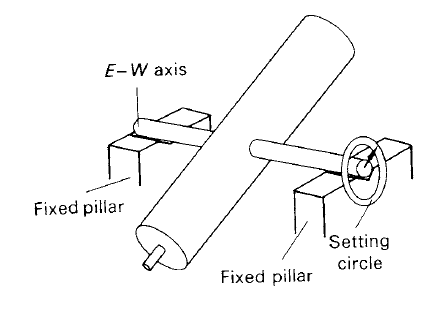


 الفيزياء الكلاسيكية
الفيزياء الكلاسيكية
 الكهربائية والمغناطيسية
الكهربائية والمغناطيسية
 علم البصريات
علم البصريات
 الفيزياء الحديثة
الفيزياء الحديثة
 النظرية النسبية
النظرية النسبية
 الفيزياء النووية
الفيزياء النووية
 فيزياء الحالة الصلبة
فيزياء الحالة الصلبة
 الليزر
الليزر
 علم الفلك
علم الفلك
 المجموعة الشمسية
المجموعة الشمسية
 الطاقة البديلة
الطاقة البديلة
 الفيزياء والعلوم الأخرى
الفيزياء والعلوم الأخرى
 مواضيع عامة في الفيزياء
مواضيع عامة في الفيزياء|
Read More
Date: 5-8-2020
Date: 19-8-2020
Date: 3-3-2016
|
The transit telescope
The transit telescope, or meridian circle, usually takes the form of a small refracting telescope but it is mounted on only one axis which is horizontal, lying along the east–west direction. In this way, the telescope is restricted to movement in one fixed plane so that it points in directions which all lie on the observatory’s meridian. The rotational axis is provided with a declination setting circle. The essential parts of the transit telescope are illustrated in figure 1 and an automated operational system is depicted in figure 2.

Figure 1. The transit telescope.
In its basic form, an eyepiece is fitted with a special graticule, the central vertical wire corresponding to the meridian. By setting the telescope to the correct altitude, the passage, or transit, of a star across the meridian can be timed accurately. This may be done by using the times of passage across each of the graticule wires in turn and taking a mean value for the transit of the central wire. At one time, the transit telescope’s function was to supply checks for master clocks which were, in turn, used to provide civil time. Nowadays, they are used to make regular checks on the rotational period of the Earth. They are also used to provide fundamental data for the purpose of determining the coordinates of celestial objects.
As with all experimental procedures, current measurements are made with electronic detectors

Figure 2. The CarlsbergMeridian Telescope with CCD detector system attached for the automatic monitoring of stellar transits. Both positions and brightnesses of over 100 000 stars are regularly recorded each night.
under computer control. The operation of the Carlsberg Meridian TelescopeW 20.7 has progressively improved since its establishment on La Palma in 1984, at that time being one of the world’s first automatic telescopes. The instrument was programmed to automatically set itself to the correct altitudes of about 500 stars in turn and measure the time of passage and their magnitudes. More recently, the photoelectric scanning-slit micrometer has been replaced by a CCD detector operating in a drift-scan mode. Between 100 000 and 200 000 stars are now measured each night and the limiting magnitude of the system is ∼17.



|
|
|
|
التوتر والسرطان.. علماء يحذرون من "صلة خطيرة"
|
|
|
|
|
|
|
مرآة السيارة: مدى دقة عكسها للصورة الصحيحة
|
|
|
|
|
|
|
نحو شراكة وطنية متكاملة.. الأمين العام للعتبة الحسينية يبحث مع وكيل وزارة الخارجية آفاق التعاون المؤسسي
|
|
|